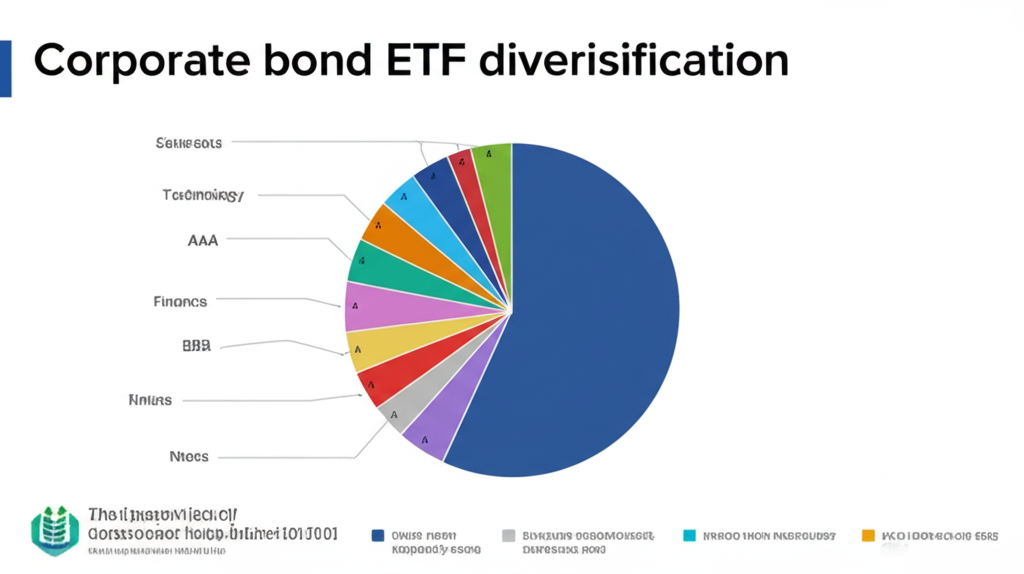Introduction: Navigating Corporate Bond ETFs for US Investors in 2025
Corporate bond ETFs have become a vital part of the US investment scene, giving investors an easy way to tap into the debt issued by major companies. Heading into 2025, these funds stand out amid possible shifts in interest rates and the need for reliable income sources. They combine broad exposure to multiple corporate borrowers with the convenience of trading like stocks on exchanges, appealing to beginners and seasoned investors alike who want to offset stock market ups and downs while building steady returns.

For US investors, corporate bond ETFs simplify access to fixed-income opportunities that might otherwise require buying individual bonds, which can be cumbersome and costly. With the economy potentially facing varied conditions in 2025-from moderate growth to inflationary pressures-these ETFs help maintain portfolio balance by providing income and acting as a buffer against equity volatility.

What Are Corporate Bond ETFs and How Do They Work?
Grasping the basics of corporate bond ETFs is key to incorporating them into your investment strategy. Corporate bonds are essentially loans to businesses, where companies issue these securities to fund operations or expansion, promising to pay back the principal at a set date along with periodic interest. Unlike Treasury bonds backed by the government, corporate bonds depend on the issuing company’s financial health.
An ETF bundles these bonds-or other assets like stocks-into a single tradable package that changes hands on stock exchanges during market hours, much like shares of a company. Corporate bond ETFs specifically pool various corporate bonds, letting you spread risk across many issuers instead of betting on just one. This setup lowers the chances that a single company’s troubles will derail your entire investment.
Standout features include duration, which gauges how much the ETF’s value might swing with interest rate moves; credit quality, a measure of the bonds’ reliability based on ratings from firms like S&P or Moody’s; yield, the expected payout from interest; and liquidity, or how smoothly shares trade without big price gaps. Together, these elements shape whether an ETF fits your goals, from conservative income plays to more aggressive growth pursuits.
Types of Corporate Bond ETFs Available to US Investors
US investors face a diverse selection of corporate bond ETFs, sorted mainly by the bonds’ credit ratings and time to maturity. Picking the right type depends on your appetite for risk and how you envision rates evolving.
Investment-Grade Corporate Bond ETFs
These ETFs focus on bonds from companies with solid track records, rated BBB- or better by rating agencies. The lower default odds make them a go-to for preserving capital while earning reliable income. In the US market, standouts like the iShares iBoxx $ Investment Grade Corporate Bond ETF (LQD) and Vanguard Short-Term Corporate Bond ETF (VCSH) deliver broad, stable exposure without excessive ups and downs.
High-Yield (Junk) Corporate Bond ETFs
Targeting riskier territory, high-yield ETFs chase bonds rated BB+ or below, where companies offer juicier interest to lure investors despite higher default possibilities. The trade-off is more price swings, but the rewards can boost returns for those comfortable with volatility. Key players include the SPDR Bloomberg High Yield Bond ETF (JNK) and iShares iBoxx $ High Yield Corporate Bond ETF (HYG), both providing diversified access to this segment.
Short-, Intermediate-, and Long-Term Corporate Bond ETFs
Maturity length, or duration, drives how these ETFs react to rate changes, with longer terms amplifying sensitivity.
- Short-term options, such as the Vanguard Short-Term Corporate Bond ETF (VCSH), keep durations low around 2-3 years, shielding against rate hikes while yielding modestly. They’re ideal for liquidity-focused US investors wary of economic uncertainty.
- Intermediate-term funds like the Vanguard Intermediate-Term Corporate Bond ETF (VCIT) hit a sweet spot with durations of 4-7 years, balancing decent yields against manageable rate exposure.
- Long-term ETFs, exemplified by the Vanguard Long-Term Corporate Bond ETF (VCLT), stretch durations beyond 10 years for top yields but invite bigger losses if rates climb. They suit long-haul investors unbothered by short-term turbulence.
Other Niche Corporate Bond ETFs
Specialized ETFs let US investors zero in on sectors like tech or energy, or opt for floating-rate versions that adjust payouts with benchmark rates, hedging against inflation. These can add tailored edges to a portfolio, though they often come with narrower focus and potentially less liquidity.
Key Benefits of Investing in Corporate Bond ETFs for US Portfolios in 2025
As 2025 approaches, corporate bond ETFs shine for their role in strengthening US portfolios through targeted advantages.
Diversification and Risk Mitigation
Spreading investments across hundreds of bonds from different companies cuts the sting of any one failure, creating a safety net that steadies the ship when stocks falter. This low correlation with equities makes them a cornerstone for resilient, all-weather portfolios.
Income Generation
These ETFs channel bond interest into regular payouts, often monthly or quarterly, fueling cash needs for retirees or income seekers. In a low-rate world, even modest yields can compound meaningfully over time.
Liquidity and Trading Flexibility
Trading on exchanges means you can enter or exit positions anytime markets are open, unlike the sluggish individual bond market. This agility lets US investors respond swiftly to news or personal shifts.
Cost-Effectiveness
With expense ratios often under 0.1%, ETFs outpace pricier mutual funds by keeping more money working for you. Passive tracking of indexes further trims overhead, enhancing net gains.
Transparency
Daily disclosures of holdings and real-time pricing empower US investors to track credit mixes and performance, fostering trust and smarter tweaks to their strategies.
Risks and Critical Considerations for US Investors in 2025
Despite their strengths, corporate bond ETFs aren’t risk-free, and 2025’s uncertainties amplify the need for caution.
- Interest Rate Risk: Rising rates devalue existing bonds, hitting longer-duration ETFs hardest as new issues pay more.
- Credit Risk: Diversification helps, but defaults remain possible, especially in high-yield funds during recessions.
- Inflation Risk: Fixed payments lose real value if prices surge, squeezing returns unless bonds include inflation adjustments.
- Liquidity Risk: Popular ETFs trade smoothly, but obscure ones may widen spreads in crises.
- Market Volatility: Broader events like elections or trade tensions can jolt bond prices, testing short-term holders.
To navigate these, US investors should match ETFs to their timeline and blend them with other assets for broader protection.
How to Choose the Best Corporate Bond ETFs for Your US Portfolio in 2025
Zeroing in on the ideal ETFs starts with your unique profile and 2025 expectations, ensuring alignment for optimal results.
Align with Investment Goals and Risk Tolerance
Define if income, safety, or growth drives you-low-risk types suit conservatives, while yield-chasers might lean high-risk. Factor in your timeline: short horizons favor brief durations to dodge rate surprises.
Evaluate Key Metrics
Scrutinize costs via expense ratios, projected returns through yield to maturity, rate vulnerability with effective duration, bond ratings for quality, and issuer count for true spread. Tools from providers can benchmark these against peers.
Consider Leading Providers
Trusted names like Vanguard, iShares (from BlackRock), Schwab, and Fidelity deliver reliable, low-fee options with high trading volume, simplifying choices for US investors.
Top Corporate Bond ETFs for US Investors (Examples for 2025):
These selections highlight versatile picks for different needs in 2025:
- Vanguard Total Corporate Bond ETF (VTC): Covers the full spectrum of investment-grade US corporate bonds across maturities, delivering all-in-one diversification at rock-bottom costs for comprehensive yield curve plays.
- iShares iBoxx $ Investment Grade Corporate Bond ETF (LQD): A heavyweight in liquidity and size, it tracks a broad index of USD investment-grade bonds, perfect for steady, moderate-income strategies.
- SPDR Bloomberg High Yield Bond ETF (JNK): Targets high-yield USD bonds for income hunters tolerant of swings, offering wide exposure to riskier corporates.
Table 1: Key Characteristics of Selected Corporate Bond ETFs for US Investors (2025)
| ETF Ticker | Name | Credit Quality | Duration (Years) | Expense Ratio | Primary Focus |
|---|---|---|---|---|---|
| VTC | Vanguard Total Corporate Bond ETF | Investment-Grade | ~6.5 | 0.04% | Broad US corporate bond market |
| LQD | iShares iBoxx $ Investment Grade Corp Bond | Investment-Grade | ~8.5 | 0.15% | Liquid US investment-grade bonds |
| JNK | SPDR Bloomberg High Yield Bond ETF | High-Yield | ~4.0 | 0.40% | Diversified US high-yield bonds |
| VCSH | Vanguard Short-Term Corporate Bond ETF | Investment-Grade | ~2.5 | 0.04% | Shorter duration, lower rate risk |
| VCIT | Vanguard Intermediate-Term Corporate Bond | Investment-Grade | ~5.5 | 0.04% | Moderate duration, balanced risk |
| VCLT | Vanguard Long-Term Corporate Bond ETF | Investment-Grade | ~13.0 | 0.04% | Longer duration, higher yield/risk |
Note: Data points are approximate and subject to change. Investors should always consult the most current prospectus and fund information.
Investing in Corporate Bond ETFs: A Guide to US Brokerage Platforms in 2025
Getting into corporate bond ETFs means choosing a solid brokerage that fits your style, whether for straightforward buys or advanced tactics like CFDs. Look at commissions, tools, education, support, and US-friendly regulations when picking for 2025.
Top Platforms for US ETF Investors (Including CFD Access):
For versatile ETF access, including CFDs that let you bet on price shifts without full ownership-useful for leverage or shorting-top brokers offer tailored setups. These can enhance strategies around corporate bonds amid 2025’s rate outlook.
- 1. Moneta Markets:
Moneta Markets excels for US investors eyeing active trades, with tight spreads on ETF CFDs for leveraged or hedging plays in bonds. It features platforms like MetaTrader 4 and 5 for in-depth charting, bots, and alerts. Holding an FCA license, it ensures a regulated, clear environment for global users, including Americans, backed by top-tier support and learning materials for beyond-basic investing. - 2. OANDA:
A staple in global trading, OANDA delivers clear costs, sharp tools, and deep insights. US clients get CFD access, possibly on ETFs, for directional bets. Its intuitive interface serves all levels, with solid research and multi-jurisdiction oversight like CFTC and NFA. - 3. FOREX.com:
Dominant in forex and CFDs, FOREX.com opens doors to broad markets, including ETF CFDs. It shines with analytics, tutorials, and a sturdy platform for US traders tracking bond trends.
Table 2: Comparison of Selected Brokerage Platforms for US Investors (2025)
| Feature | Moneta Markets | OANDA | FOREX.com |
|---|---|---|---|
| ETF Access Type | ETF CFDs (Leveraged trading) | ETF CFDs (Speculative trading) | ETF CFDs (Market exposure) |
| Trading Platforms | MetaTrader 4, MetaTrader 5, WebTrader | fxTrade, MetaTrader 4, Web trading | proprietary platform, MetaTrader 4 |
| Spreads/Fees | Highly competitive spreads on CFDs | Transparent, competitive spreads | Competitive spreads, clear fee structure |
| Regulatory Standing | Strong international (FCA) for global clients; specific offerings for US clients | Regulated in multiple jurisdictions, including US (CFTC, NFA) | Regulated in multiple jurisdictions, including US (CFTC, NFA) |
| Research & Education | Comprehensive resources, market analysis | Robust research, market insights | Strong research, educational content |
| Customer Support | Excellent, multi-channel support | Responsive, multi-language support | Reliable, dedicated support |
Note: Specific CFD offerings for ETFs may vary by region and regulatory restrictions. Investors should verify availability for their specific location.
Strategic Allocation: Integrating Corporate Bond ETFs into Your US Portfolio
Blending corporate bond ETFs thoughtfully can elevate your US portfolio’s performance, tailored to 2025’s projections like steady growth or rate tweaks.
Portfolio Diversification Strategies
As a counterweight to stocks, allocate 20-40% to bonds, with corporate ETFs as the backbone-say, 15-20% investment-grade and a dash of high-yield. This mix tempers volatility, as bonds often zig when stocks zag, proven in past downturns.
Income Generation Strategies
For steady payouts, lean on monthly-distributing ETFs to mimic a paycheck. A barbell approach pairs short-term safety with long-term yield, or stick to intermediates like VCIT for reliable middle-ground income without overcommitting to rates.
Managing Interest Rate Sensitivity
With 2025 rates in flux, prioritize duration control.
- Short-duration picks like VCSH weather hikes best, keeping principal intact.
- Laddering spreads maturities to reinvest as bonds roll over, averaging out rate impacts over years.
US Tax Efficiency Considerations
Taxes matter for bond income, so plan accordingly.
- Distributions: Counted as ordinary income, taxed at your bracket-often steeper than gains.
- Capital Gains: Short holds draw income rates; longer ones get favorable long-term treatment.
- Account Types: Shelter in IRAs or 401(k)s to delay or skip taxes. In taxable accounts, harvest losses to offset wins. For deeper dives, check IRS Publication 550, Investment Income and Expenses.
Table 3: Tax Implications Overview for Corporate Bond ETFs in the US
| Account Type | Income Tax Treatment (Distributions) | Capital Gains Tax Treatment (Sales) | Key Advantage |
|---|---|---|---|
| Taxable Brokerage | Ordinary Income (marginal rate) | Short-term (marginal), Long-term (preferential) | Flexibility, liquidity |
| Traditional IRA/401(k) | Tax-deferred | Tax-deferred | Contributions tax-deductible, growth untaxed until withdrawal |
| Roth IRA/401(k) | Tax-free | Tax-free | Qualified withdrawals are tax-free |
The Future Outlook for Corporate Bond ETFs in the United States (2025 Forecast)
Corporate bond ETFs in the US look set for an intriguing 2025, driven by key forces.
The Federal Reserve’s moves will steer the ship-stabilizing rates might lift long bonds, while hikes benefit shorts. Strong GDP could bolster corporate balance sheets, easing defaults; slowdowns would spotlight high-yield vulnerabilities. Innovation may bring ESG-tilted or industry-focused ETFs, aligning with investor values, alongside fee cuts from rivalry. Watch SEC updates at U.S. Securities and Exchange Commission (SEC) for rule shifts affecting trades.
Conclusion: Making Informed Investment Decisions in 2025
In 2025, corporate bond ETFs equip US investors with diversification, income, and stability tools. Grasping varieties, pros, cons, and integration tactics sharpens choices, while platforms like Moneta Markets add flexibility via CFDs. Track forecasts and regs to steer your portfolio toward enduring success.
Frequently Asked Questions (FAQs) about Corporate Bond ETFs Investing in the US
What is the Vanguard Total Corporate Bond ETF, and how does it perform in the US market?
The Vanguard Total Corporate Bond ETF (VTC) tracks a wide index of USD investment-grade corporate bonds across short, intermediate, and long maturities, giving full-market access. It has delivered solid, low-cost performance historically, blending stability and income for US portfolios seeking broad fixed-income coverage.
Are corporate bond ETFs a good investment in the United States for 2025, given current market conditions?
Yes, they can suit US investors in 2025 for spreading risk and creating income, hinging on goals, tolerance, and rates. Though exposed to rate and credit pressures, their spread and ease of trade add value against stock swings.
What are the best corporate bond ETFs for high yield that US investors can consider?
High-yield seekers might eye the SPDR Bloomberg High Yield Bond ETF (JNK) or iShares iBoxx $ High Yield Corporate Bond ETF (HYG), which target lower-rated bonds for bigger payouts amid added default and fluctuation risks-fitting for bolder US investors.
What is the primary difference between investment-grade and high-yield corporate bond ETFs for a US portfolio?
Credit ratings set them apart: investment-grade ETFs stick to high-rated, low-default bonds for safe, even yields; high-yield ones venture into speculative territory for superior income but elevated risks. US choices reflect risk comfort and return aims.
How do long-term corporate bond ETFs typically perform when interest rates are rising in the US?
Their long durations make them vulnerable, so rising US rates usually drop their values as fresh bonds outyield the old ones, prompting price dips for holders of these ETFs.
Which iShares 1-5 year investment grade corporate bond ETF is recommended for short-duration exposure in the United States?
The iShares 1-5 Year Investment Grade Corporate Bond ETF (IGSB) fits the bill for US short-term needs, honing in on 1-5 year maturities to curb rate swings while securing consistent income versus longer peers.
Are corporate bond ETFs taxable in the US, and what are the tax implications for distributions?
They are taxable: distributions hit as ordinary income at your rate, and sale gains follow hold-time rules. Tax-sheltered spots like IRAs or 401(k)s help US investors optimize by postponing or nixing the bite.
How can I invest in corporate bond ETFs in the United States, and which brokers offer flexible options?
Open a brokerage account, fund it, and buy shares on exchanges. For extras like CFD leverage, Moneta Markets delivers tight ETF CFD spreads and MetaTrader platforms, ideal for US traders wanting versatile bond market action.
What are the main risks associated with corporate bond ETFs investing that US investors should be aware of?
Key threats include rate rises tanking prices, issuer defaults, inflation eating gains, plus volatility and occasional liquidity snags-essentials for US investors to weigh in their plans.
Should I consider corporate bond ETFs for retirement planning in the United States in 2025?
Absolutely, they bolster retirement via income, balance, and calm-prime for 2025 planners. Tuck them into IRAs or 401(k)s for tax perks, matching your timeline and risk profile.



No responses yet